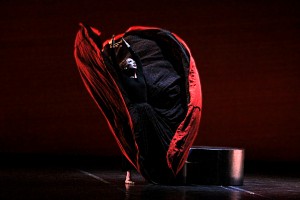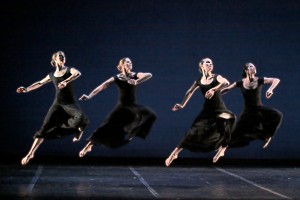Note: This review marks the continuation of a series dedicated to showcasing the best student writing from the Dance History class I teach at The Juilliard School.
By Michael Marquez
Martha Graham’s Chronicle speaks against the rise of fascism, but it also reveals a universal message. Everyone should fight for causes. On September 30 at New York City Center, The Martha Graham Dance Company’s performance of Graham’s 1936 masterwork concluded the second program of the Fall for Dance Festival.
Chronicle opens with a lone figure. Wearing a long, heavy black skirt and sitting on a round-shaped platform, Blakely White-McGuire manipulates yards of her costume. Her skirt becomes a psychological extension of her being. It looks like the psychic weight she carries. It invites fascination. When she unfolds the skirt’s red underside, it is as though she is shedding her own blood. While White-McGuire’s focus is captivating and fearless, her full-bodied gestures show her fight.
In the second section, “Steps in the Street,” nine dancers step, jump and twist as one. On the dark-lit stage, with its black floor and cyclorama, Wallingford Riegger’s music drives the performers into a primordial state. Their impassioned dancing looks like it is being spun from their inner impulses. They dig deep into the ground, rooting them selves to the stage to form archaic and statuary-like shapes.
The strong and vigorous women fight humanely, instead of devolving into immorally behaving creatures. Unfortunately, too many of the dancers’ transitions lack suppleness. Or, as master Graham teacher Terese Capucilli puts it, their transitions lack “thickness.”
Nonetheless, Chronicle shows how much emotion is inside of us. We should never ignore what we feel. We should never forget that it’s necessary to fight for causes. A vanguard artist of the last century, Graham made essential dances. Chronicle is one of Graham’s works that continues to strike at the human heart.
Michael Marquez is a second year student in the Dance Division. He studies the Graham technique with Terese Capucilli.

